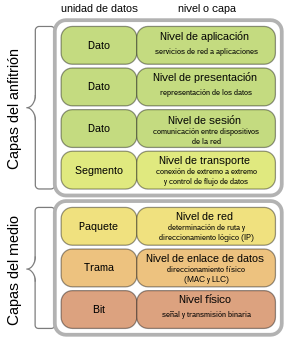Physical layer
In the seven layers of the OSI model of the computer network, the physical layer or physical layer (Layer 1) refers to the transformations that are made to the sequence of bits to transmit them from one place to another. This layer can be implemented by a PHY. The bits are always handled within the PC as electrical levels. For example, it can be said that at a point on the cable there is a 1 when a certain voltage level is present and a zero when its level is 0 volts. When the bits are transmitted they are always transformed into other types of signals in such a way that the receiving point can recover the original bit sequence.
The Physical Layer or Tier 1 provides the mechanical, electrical, functional, and procedural means to activate, maintain, and deactivate physical connections.
Transmission media
The transmission medium constitutes the channel that allows the transmission of information between two terminals in a communication system.
Transmissions are usually made using physical media and electromagnetic waves, which become susceptible when transmitted through a vacuum.
Lattice
The physical layer provides services to the data link layer in order for the data link layer to provide services to the network layer. The physical layer receives a stream of bits and tries to send it to the destination, and it is not its responsibility to deliver them free of errors. The data link layer is responsible for detecting and correcting errors. The errors may consist of a greater or lesser number of bits received or differences in the values that were emitted and those that were received.
A common method of error detection is for the data link layer to break the stream into separate frames and checksum each frame. When a frame reaches its destination, the checksum is recalculated. If it is different from the one contained in the frame, it is because an error has occurred and the link layer must solve it. to
Layer functions and services
The main functions and services performed by the physical layer are:
- Bit-to-bit shipping between nodes
- Provide a standardized interface for physical transmission media, including:
- Mechanical specifications of electrical connectors and cables, for example maximum cable length
- Electrical specification of the transmission line, signal level and impedance
- Radio interface, including electromagnetic spectrum, frequency allocation and signal power specification, analog bandwidth, etc.
- Specifications for IR on optical fiber or wireless communication connection via IR
- Modulation
- Line coding
- Synchronization of bits in synchronic series communication
- Delimitation of start and end, and flow control in asynchronous series communication
- Multiplexing circuit switching
- Carrier Detection and Collision Detection Used by Some Level 2 Multiple Access Protocols
- Equalization, filtering, test sequences, pulse conformation and other physical signal processing
The physical layer is also concerned with:
- Line configuration point to point, multipoint or point to multipoint
- Physical topology of the network, for example by bus, ring, mesh or star
- Serial or parallel communication
- Simplex transmission mode, half duplex or full duplex
Physical signaling sublayer
In a local area network (LAN) or metropolitan area network (MAN) using the OSI architecture, the physical signaling sublayer is the part of the physical layer that:
- is related to the MAC sublayer that is a part of the Data Link layer
- performs character encoding, transmission, reception and decoding
Source: Federal Standard 1037C
Examples
Protocol Examples
- V.92 modem telephone network
- xDSL
- IrDA physical layer
- USB physical layer
- Firewire
- EIA RS-232, EIA-422, EIA-423, RS-449, RS-485
- UTI Recommendations: See ITU-T
- DSL
- ISDN
- T1 and other T-carrier links, and E1 and other E-carrier links
- 10BASE-T, 10BASE2, 10BASE5, 100BASE-TX, 100BASE-FX, 100BASE-T, 1000BASE-T, 1000BASE-SX and other varieties of the physical layer of Ethernet
- SONET/SDH
- GSM radio interface
- Bluetooth physical layer
- IEEE 802.11x Wi-Fi physical layers
Examples of hardware equipment
- Repeater
- Hub Ethernet
- Modem
Note: Physical Layer Associated with the transmission of unstructured bit streams over a physical link. Responsible for the mechanical, electrical, and procedural characteristics that establish, maintain, and deactivate the physical link.
Contenido relacionado
Session layer
SCADA
Binary system
